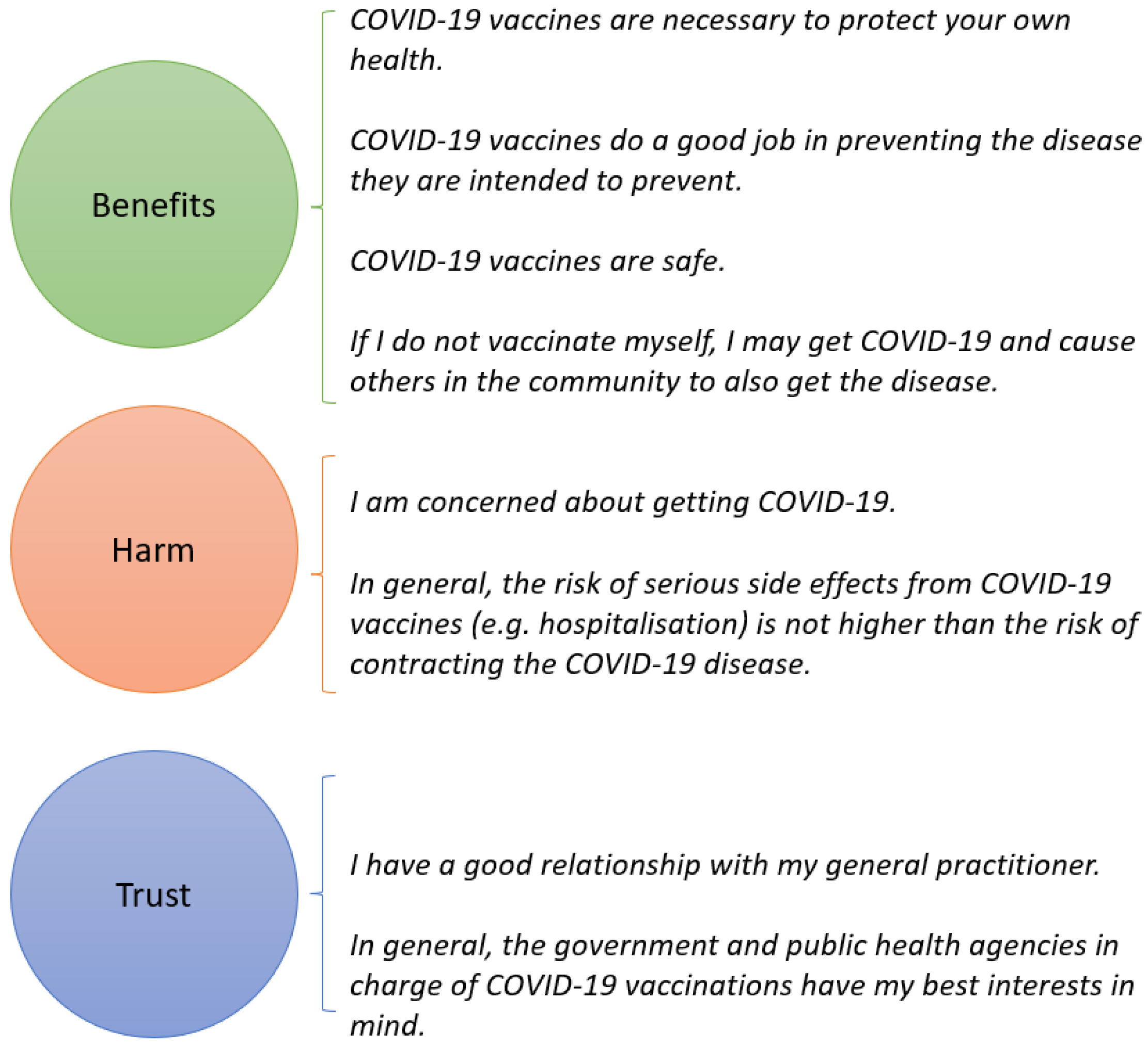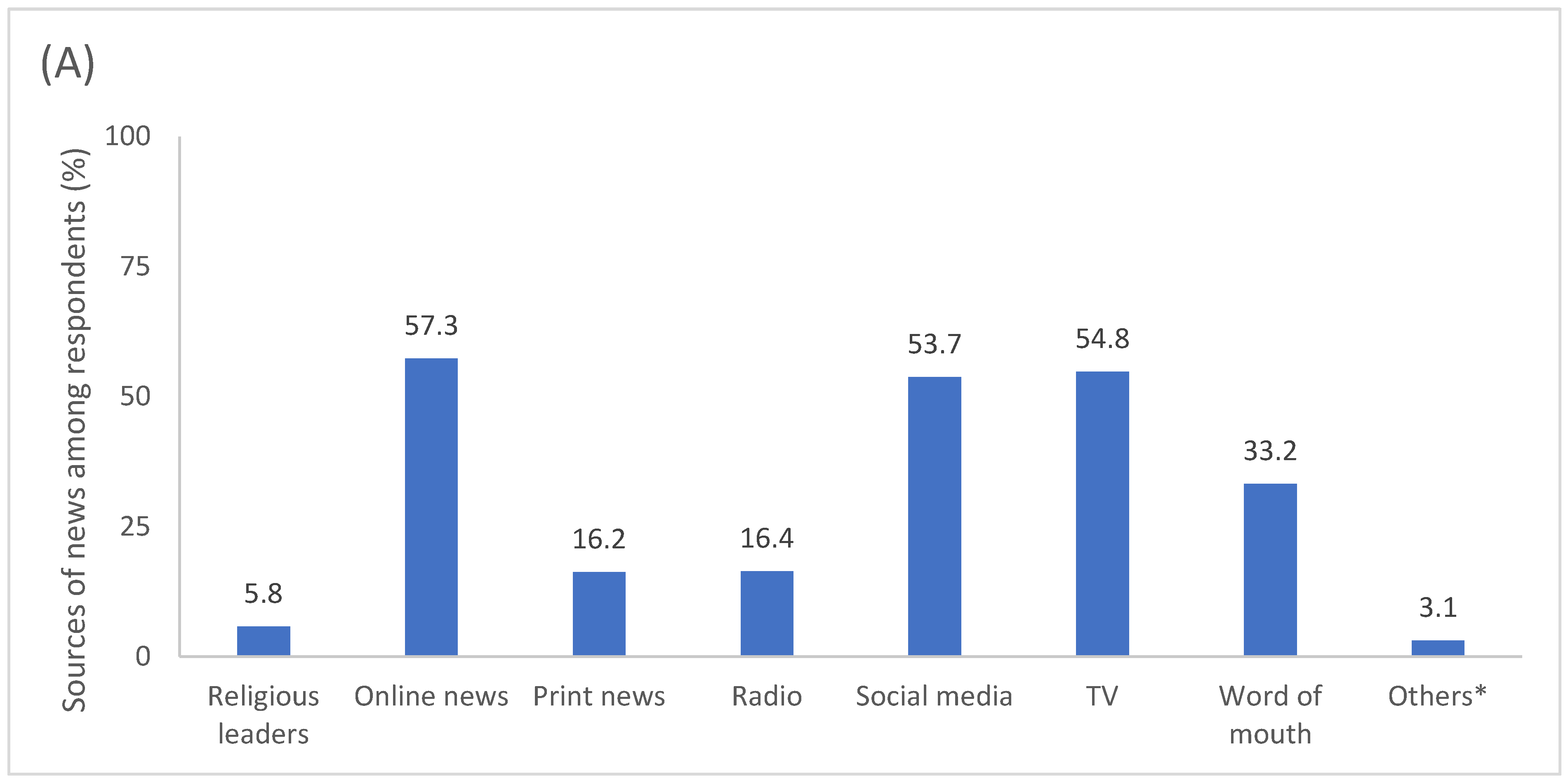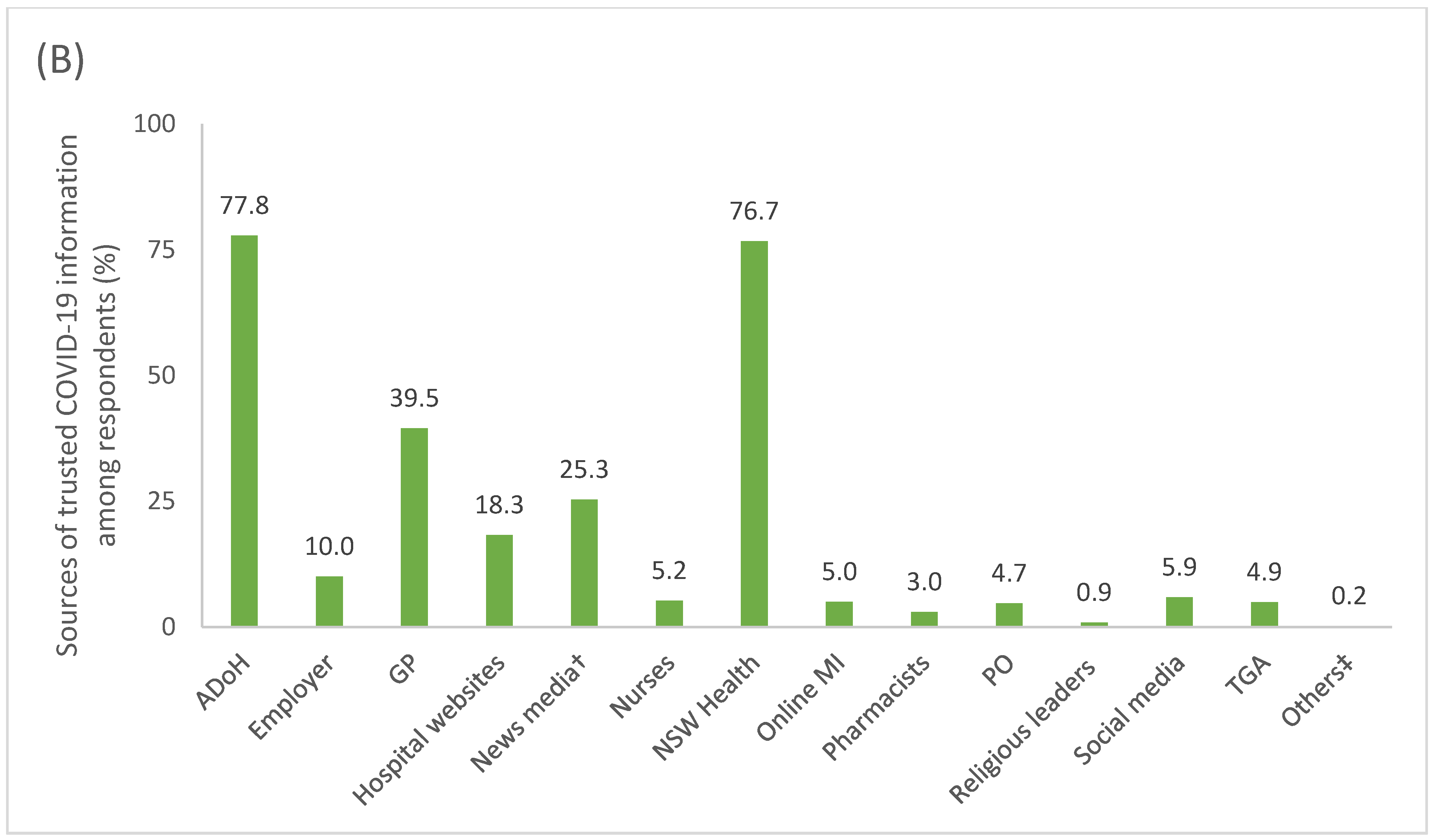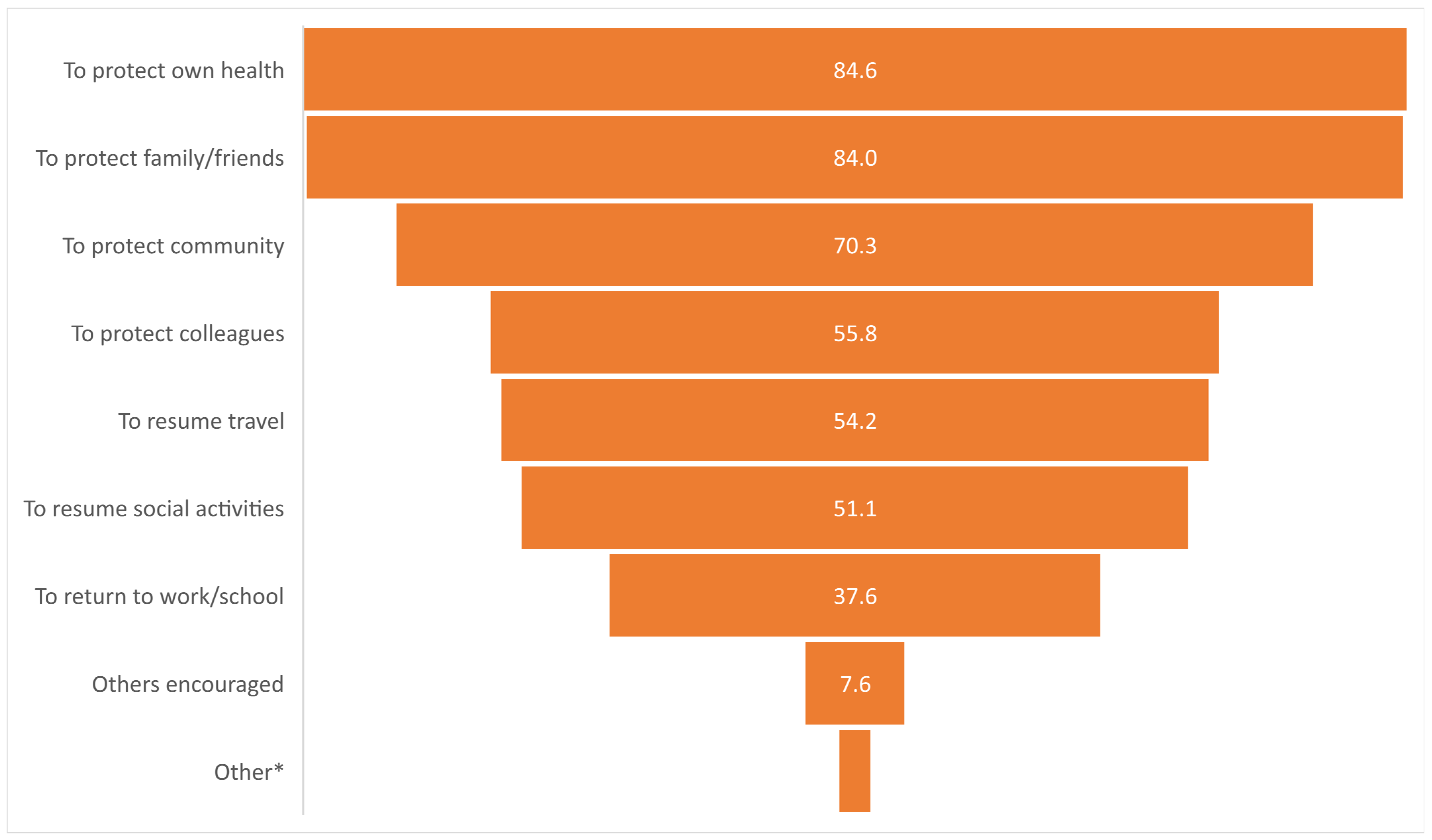Factors Influencing COVID-19 Vaccine Confidence and Uptake in Australian Adults
Abstract
1. Introduction
2. Materials and Methods
2.1. Study Design and Data Collection
2.2. Measures
2.3. Data Analysis
3. Results
3.1. Sources of News and COVID-19 Information
3.2. Motivators for Receiving a Vaccination
3.3. Predictors of High Vaccine Confidence
4. Discussion
5. Conclusions
Supplementary Materials
Author Contributions
Funding
Institutional Review Board Statement
Informed Consent Statement
Data Availability Statement
Conflicts of Interest
References
- Australian Department of Health. First Confirmed Case of Novel Coronavirus in Australia. 2020. Available online: https://www.health.gov.au/ministers/the-hon-greg-hunt-mp/media/first-confirmed-case-of-novel-coronavirus-in-australia (accessed on 19 November 2023).
- World Health Organization. WHO Coronavirus (COVID-19) Dashboard. Available online: https://covid19.who.int/region/wpro/country/au (accessed on 19 November 2023).
- Australian Department of Health. COVID-19 Vaccination—Australia’s COVID-19 Vaccine National Roll-out Strategy. 2021. Available online: https://www.health.gov.au/resources/publications/covid-19-vaccination-australias-covid-19-vaccine-national-roll-out-strategy (accessed on 19 November 2023).
- Kaufman, J.; Tuckerman, J.; Danchin, M. Overcoming COVID-19 vaccine hesitancy: Can Australia reach the last 20 percent? Expert Rev. Vaccines 2022, 21, 159–161. [Google Scholar] [CrossRef]
- Leask, J.; Carlson, S.J.; Attwell, K.; Clark, K.K.; Kaufman, J.; Hughes, C.; Frawley, J.; Cashman, P.; Seal, H.; Wiley, K.; et al. Communicating with patients and the public about COVID-19 vaccine safety: Recommendations from the Collaboration on Social Science and Immunisation. Med. J. Aust. 2021, 215, 9–12.e11. [Google Scholar] [CrossRef] [PubMed]
- Australian Therapeutic Goods Administration. AstraZeneca ChAdOx1-S COVID-19 Vaccine: Updated Safety Advisory—Rare and Unusual Blood Clotting Syndrome (Thrombosis with Thrombocytopenia). Available online: https://www.tga.gov.au/news/media-releases/astrazeneca-chadox1-s-covid-19-vaccine (accessed on 19 November 2023).
- World Health Organization. Understanding the Behavioural and Social Drivers of Vaccine Uptake WHO Position Paper. 2022. Available online: https://www.who.int/publications/i/item/who-wer9720-209-224 (accessed on 19 November 2023).
- Dubé, E.; Laberge, C.; Guay, M.; Bramadat, P.; Roy, R.; Bettinger, J. Vaccine hesitancy: An overview. Hum. Vaccines Immunother. 2013, 9, 1763–1773. [Google Scholar] [CrossRef] [PubMed]
- Larson, H.J.; Schulz, W.S.; Tucker, J.D.; Smith, D.M. Measuring vaccine confidence: Introducing a global vaccine confidence index. PLoS Curr. 2015, 7. [Google Scholar] [CrossRef] [PubMed]
- Murch, S.H.; Anthony, A.; Casson, D.H.; Malik, M.; Berelowitz, M.; Dhillon, A.P.; Thomson, M.A.; Valentine, A.; Davies, S.E.; Walker-Smith, J.A. Retraction of an interpretation. Lancet 2004, 363, 750. [Google Scholar] [CrossRef]
- Vaccine Confidence Project: Our Mission. Available online: https://www.vaccineconfidence.org/ (accessed on 1 June 2024).
- Summary WHO SAGE Conclusions and Recommendations on Vaccine Hesitancy. 2015. Available online: https://cdn.who.int/media/docs/default-source/immunization/demand/summary-of-sage-vaccinehesitancy-en.pdf?sfvrsn=abbfd5c8_2 (accessed on 18 November 2023).
- Vaccine Confidence Project. State of Vaccine Confidence in EU, 2022. 2022. Available online: https://www.vaccineconfidence.org/our-work/reports/state-of-vaccine-confidence-in-eu-2022/ (accessed on 1 June 2024).
- Salmon, D.A.; Dudley, M.Z. It is time to get serious about vaccine confidence. Lancet 2020, 396, 870–871. [Google Scholar] [CrossRef] [PubMed]
- Sprengholz, P.; Betsch, C. Herd immunity communication counters detrimental effects of selective vaccination mandates: Experimental evidence. EClinicalMedicine 2020, 22, 100352. [Google Scholar] [CrossRef]
- Enticott, J.; Gill, J.S.; Bacon, S.L.; Lavoie, K.L.; Epstein, D.S.; Dawadi, S.; Teede, H.J.; Boyle, J. Attitudes towards vaccines and intention to vaccinate against COVID-19: A cross-sectional analysis-implications for public health communications in Australia. BMJ Open 2022, 12, e057127. [Google Scholar] [CrossRef]
- Wang, B.; Nolan, R.; Krumeich, B.; D’Onise, K.; Marshall, H. COVID-19 vaccine willingness prior to and during the COVID-19 vaccination rollout in Australia. Hum. Vaccines Immunother. 2022, 18, 2079345. [Google Scholar] [CrossRef]
- Biezen, R.; Kaufman, J.; Hoq, M.; Manski-Nankervis, J.A.; Sanci, L.; Bell, J.S.; Leask, J.; Seale, H.; Munro, J.; Suryawijaya Ong, D.; et al. Factors impacting COVID-19 vaccine decision making in older adults and people with underlying conditions in Victoria, Australia: A cross-sectional survey. Hum. Vaccines Immunother. 2022, 18, 2147770. [Google Scholar] [CrossRef]
- Royal Australian College of General Practitioners. News: Government clarifies GPs’ Position as States Expand Pfizer Eligibility. 2021. Available online: https://www1.racgp.org.au/newsgp/clinical/gps-given-green-light-to-mirror-states-on-pfizer-e (accessed on 19 November 2023).
- Western Sydney Local Health District—NSW Government. Blacktown Mount Druitt Hospital. 2023. Available online: https://www.wslhd.health.nsw.gov.au/Blacktown-Mount-Druitt-Hospital/About-BMDH/Our-History (accessed on 20 January 2024).
- Centres for Disease Control and Prevention. COVID-19 Vaccine Confidence: Rapid Community Assessment Tool. 2021. Available online: https://www.cdc.gov/vaccines/covid-19/vaccinate-with-confidence/rca-guide/downloads/CDC_RCA_Guide_2021_Tools_AppendixD_Surveys-508.pdf (accessed on 19 November 2023).
- Gilkey, M.B.; Reiter, P.L.; Magnus, B.E.; McRee, A.L.; Dempsey, A.F.; Brewer, N.T. Validation of the Vaccination Confidence Scale: A Brief Measure to Identify Parents at Risk for Refusing Adolescent Vaccines. Acad. Pediatr. 2016, 16, 42–49. [Google Scholar] [CrossRef] [PubMed]
- Bentler, P.M. Comparative fit indexes in structural models. Psychol. Bull. 1990, 107, 238–246. [Google Scholar] [CrossRef] [PubMed]
- Byrne, B.M. Structural Equation Modeling With AMOS, EQS, and LISREL: Comparative Approaches to Testing for the Factorial Validity of a Measuring Instrument. Int. J. Test. 2001, 1, 55–86. [Google Scholar] [CrossRef]
- Taber, K.S. The Use of Cronbach’s Alpha When Developing and Reporting Research Instruments in Science Education. Res. Sci. Educ. 2018, 48, 1273–1296. [Google Scholar] [CrossRef]
- Leung, J.; Price, D.; McClure-Thomas, C.; Bonsaksen, T.; Ruffolo, M.; Kabelenga, I.; Lamph, G.; Geirdal, A. Motivation and Hesitancies in Obtaining the COVID-19 Vaccine-A Cross-Sectional Study in Norway, USA, UK, and Australia. Vaccines 2023, 11, 1086. [Google Scholar] [CrossRef]
- Kleitman, S.; Fullerton, D.J.; Law, M.K.H.; Blanchard, M.D.; Campbell, R.; Tait, M.A.; Schulz, J.; Lee, J.; Stankov, L.; King, M.T. The Psychology of COVID-19 Booster Hesitancy, Acceptance and Resistance in Australia. Vaccines 2023, 11, 907. [Google Scholar] [CrossRef] [PubMed]
- Gilkey, M.B.; Magnus, B.E.; Reiter, P.L.; McRee, A.-L.; Dempsey, A.F.; Brewer, N.T. The Vaccination Confidence Scale: A brief measure of parents’ vaccination beliefs. Vaccine 2014, 32, 6259–6265. [Google Scholar] [CrossRef]
- de Figueiredo, A.; Simas, C.; Karafillakis, E.; Paterson, P.; Larson, H.J. Mapping global trends in vaccine confidence and investigating barriers to vaccine uptake: A large-scale retrospective temporal modelling study. Lancet 2020, 396, 898–908. [Google Scholar] [CrossRef]
- Croucher, S.M.; Ashwell, D.; Cullinane, J.; Murray, N.; Nguyen, T. Vaccine confidence in New Zealand: Understanding the influences of demographic characteristics and patient self-advocacy. Atl. J. Commun. 2023, 32, 403–414. [Google Scholar] [CrossRef]
- Nizigiyimana, A.; Acharya, D.; Morillon, G.F.; Poder, T.G. Predictors of Vaccine Acceptance, Confidence, and Hesitancy in General, and COVID-19 Vaccination Refusal in the Province of Quebec, Canada. Patient Prefer. Adherence 2022, 16, 2181–2202. [Google Scholar] [CrossRef]
- Edwards, B.; Biddle, N.; Gray, M.; Sollis, K. COVID-19 vaccine hesitancy and resistance: Correlates in a nationally representative longitudinal survey of the Australian population. PLoS ONE 2021, 16, e0248892. [Google Scholar] [CrossRef] [PubMed]
- Catalan-Matamoros, D.; Peñafiel-Saiz, C. Exploring the relationship between newspaper coverage of vaccines and childhood vaccination rates in Spain. Hum. Vaccines Immunother. 2020, 16, 1055–1061. [Google Scholar] [CrossRef] [PubMed]
- Melovic, B.; Jaksic Stojanovic, A.; Vulic, T.B.; Dudic, B.; Benova, E. The Impact of Online Media on Parents’ Attitudes toward Vaccination of Children-Social Marketing and Public Health. Int. J. Environ. Res. Public Health 2020, 17, 5816. [Google Scholar] [CrossRef] [PubMed]
- Suppli, C.H.; Hansen, N.D.; Rasmussen, M.; Valentiner-Branth, P.; Krause, T.G.; Mølbak, K. Decline in HPV-vaccination uptake in Denmark—The association between HPV-related media coverage and HPV-vaccination. BMC Public Health 2018, 18, 1360. [Google Scholar] [CrossRef] [PubMed]
- Cervi, L.; Tejedor Calvo, S.; Robledo-Dioses, K. Comunicación digital y ciudad: Análisis de las páginas web de las ciudades más visitadas en el mundo en la era de la COVID-19. Rev. Lat. Comun. Soc. 2023, 81, 81–108. [Google Scholar] [CrossRef]
- NSW Goverment: Clinical Excellence Commission. Health Literacy. Available online: https://www.cec.health.nsw.gov.au/improve-quality/teamwork-culture-pcc/person-centred-care/health-literacy#:~:text=In%20Australia%2C%2060%25%20of%20people%20have%20low%20health%20literacy (accessed on 19 November 2023).
- Hurstak, E.; Farina, F.R.; Paasche-Orlow, M.K.; Hahn, E.A.; Henault, L.E.; Moreno, P.; Weaver, C.; Marquez, M.; Serrano, E.; Thomas, J.; et al. COVID-19 Vaccine Confidence Mediates the Relationship between Health Literacy and Vaccination in a Diverse Sample of Urban Adults. Vaccines 2023, 11, 1848. [Google Scholar] [CrossRef]
- Lewandowsky, S.; Ecker, U.K.; Seifert, C.M.; Schwarz, N.; Cook, J. Misinformation and Its Correction: Continued Influence and Successful Debiasing. Psychol. Sci. Public Interest 2012, 13, 106–131. [Google Scholar] [CrossRef]




| N = 1053 | n | % |
|---|---|---|
| Gender | ||
| Female | 509 | 48.3 |
| Age | ||
| 18–24 | 105 | 10.0 |
| 25–34 | 340 | 32.3 |
| 35–44 | 408 | 38.7 |
| 45–54 | 122 | 12.0 |
| 55–64 | 55 | 5.2 |
| 65+ | 12 | 1.1 |
| Ancestry | ||
| Aboriginal/Torres Strait Islander | 3 | 0.3 |
| Australian | 303 | 28.8 |
| Chinese | 81 | 7.7 |
| English | 37 | 3.5 |
| Filipino | 63 | 6.0 |
| German | 2 | 0.2 |
| Indian | 430 | 40.8 |
| Irish | 13 | 1.2 |
| Italian | 11 | 1.0 |
| Other ancestry * | 194 | 18.4 |
| Scottish | 9 | 0.9 |
| Religion | ||
| Buddhism | 32 | 3.0 |
| Christian | 304 | 28.9 |
| Hinduism | 349 | 33.1 |
| Islam | 86 | 8.2 |
| No religion | 226 | 21.5 |
| Other religion † | 24 | 2.3 |
| Sikhism | 25 | 2.4 |
| Education | ||
| Less than high school | 8 | 0.8 |
| High school | 165 | 15.7 |
| Bachelor’s degree | 469 | 44.5 |
| Master’s degree | 340 | 32.3 |
| PhD or higher | 18 | 1.7 |
| Trade school | 48 | 4.6 |
| Income | ||
| $1–500 per week | 90 | 8.5 |
| $501–1000 per week | 161 | 15.3 |
| $1001–1500 per week | 203 | 19.3 |
| $1501–2000 per week | 181 | 17.2 |
| $2001–2500 per week | 150 | 14.2 |
| >$2500 per week | 257 | 24.4 |
| Medical condition assoc. high risk of severe COVID-19 ‡ | ||
| Yes | 231 | 21.9 |
| HCP recommended the vaccine | ||
| Yes | 317 | 30.1 |
| Previous COVID-19 experience § | ||
| Yes | 212 | 20.1 |
| Univariate Analysis | Multivariate Analysis | |||||
|---|---|---|---|---|---|---|
| OR | 95% CI | p Value | OR | 95% CI | p Value | |
| Age | 0.99 | 0.97–0.99 | 0.036 | 0.99 | 0.97–1.00 | 0.107 |
| Australian | 0.72 | 0.53–0.98 | 0.037 | 0.78 | 0.56–1.09 | 0.146 |
| University degree | 1.43 | 1.03–2.00 | 0.034 | 1.18 | 0.82–1.71 | 0.372 |
| ADoH | 1.64 | 1.18–2.27 | 0.003 | 1.43 | 1.02–2.00 | 0.041 |
| NSWH | 1.46 | 1.06–2.02 | 0.021 | 1.33 | 0.95–1.87 | 0.093 |
| Social media | 0.51 | 0.30–0.88 | 0.015 | 0.60 | 0.34–1.05 | 0.075 |
| Exposure to fake news | 0.71 | 0.53–0.96 | 0.024 | 0.71 | 0.52–0.96 | 0.025 |
Disclaimer/Publisher’s Note: The statements, opinions and data contained in all publications are solely those of the individual author(s) and contributor(s) and not of MDPI and/or the editor(s). MDPI and/or the editor(s) disclaim responsibility for any injury to people or property resulting from any ideas, methods, instructions or products referred to in the content. |
© 2024 by the authors. Licensee MDPI, Basel, Switzerland. This article is an open access article distributed under the terms and conditions of the Creative Commons Attribution (CC BY) license (https://creativecommons.org/licenses/by/4.0/).
Share and Cite
Williams, C.T.; Saini, B.; Zaidi, S.T.R.; Kali, C.; Moujalli, G.; Castelino, R. Factors Influencing COVID-19 Vaccine Confidence and Uptake in Australian Adults. Vaccines 2024, 12, 627. https://doi.org/10.3390/vaccines12060627
Williams CT, Saini B, Zaidi STR, Kali C, Moujalli G, Castelino R. Factors Influencing COVID-19 Vaccine Confidence and Uptake in Australian Adults. Vaccines. 2024; 12(6):627. https://doi.org/10.3390/vaccines12060627
Chicago/Turabian StyleWilliams, Charles Travers, Bandana Saini, Syed Tabish R. Zaidi, Christina Kali, Grace Moujalli, and Ronald Castelino. 2024. "Factors Influencing COVID-19 Vaccine Confidence and Uptake in Australian Adults" Vaccines 12, no. 6: 627. https://doi.org/10.3390/vaccines12060627
APA StyleWilliams, C. T., Saini, B., Zaidi, S. T. R., Kali, C., Moujalli, G., & Castelino, R. (2024). Factors Influencing COVID-19 Vaccine Confidence and Uptake in Australian Adults. Vaccines, 12(6), 627. https://doi.org/10.3390/vaccines12060627







